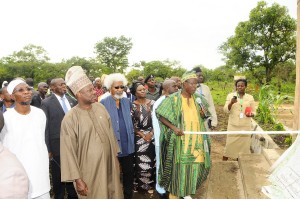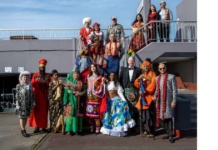When, out of the blues, a king joins up with other kings of cultural and heritage affiliation to found a homeland, not for their immediate subjects but for their subjects lost, dead, and far flung to the corners of the earth, then it is a call for home-coming.
So it is that the Olofin II, Olofindji Akande, a king in the Republic of Benin, envisioned a sense of re-unification of the Yoruba nationhood without borders where all that could find their ancestry and those departed as a result of the slave trade could be re-united to their past and the their present.
Whereas this may seem quite wacky but the cultural altruisms of the Yorubas does not accept the alienation of one’s heritage whether physically or spiritually. This, however, takes for granted that the trauma of the trans-Atlantic slavery has never truly healed as their are still so many people pining for their spiritual and physical heritage for their physical lives to have meaning.
The Olofin II has thus attempted to provide this succour to give a new beginning and a future by building an independent city between two countries, Benin and Nigeria, named Igbale-aiye. Igbale-aiye, in the Yoruba language could be translated to mean ‘the place of rest for the world’- the Yoruba world. And when this is tied into the concept of ‘the departed souls find rest at home’, then it becomes an ancestral habitation for all generations living or dead.
In the English parlance, it is christened the African Renaissance City, and designed as “home for all nations, black people in particular, and irrespective of nationalities”, “to become one and free” from the nation state borders created by colonialism.
It is “in tribute to departed and enslaved African Ancestors”, a documents on the project states.
“Quietly starting from the scratch with several culture-related events spread across the year, African Renaissance City is designed to cover border areas of Republic of Benin and Nigeria, with as much as 600, 000 acres expected to be taken across the two countries. Already notable personalities such as Bishop Desmond Tutu, Prof. Wole Soyinka, American civil right activist, Rev Jesse Jackson, Late Ambassador Segun Olusola, Giles and Yvette Saverd-Forget, among others have been inducted into the African Renaissance consciousness during the last five years of the project.”
“It’s a concept that started 30 years ago,” the founder, the Olofin II profferedas he led over three hours procession of the 2013 edition of the African Renaissance convention titled Humanism at the Benin rural area of Akpotokou, near Ilara, a border town between Ogun State and Republic of Benin. About an hour earlier, the Olofin II had, on behalf of African Renaissance, honoured over 10 people including royal fathers from the border towns and some young enthusiasts of the projects.
Also, posthumous honours were given to Ambassador Segun Olusola and a Beninese Erin Ilu Rabiu Asabi Adeaga. Among top dignitaries and multitude of pilgrims at the entrance of the future city where the ceremony held were familiar faces such as a monarch, the Fadesewa of Simawa, Ijebu, Oba Gbenga Sonuga, Thomas Atanda Idowu, Arolagbade II of Dinyin and former Director-General, Voice of Nigeria (VON) Chief Taiwo Alimi.
The concept, the Olofin II stated, was inspired by what he described as the needs for Africans to have a centre of spiritual convergence. He therefore sees African Renaissance as the Blacks’ “Vatican City”, where people across nations will feel at home, except that unlike the Roman city, “African Renaissance is not based on one religion; its home for all faiths.”
And in seeking support for the project, the Olofin II disclosed that “it has the recognition and support of UNESCO.”
At the period of the visit, there were activities spread across three days, involving visitors from the African continent and the Caribbean. However, the only visible structure was what looked like the entrance to the future city; a huge plaque, erected as one makes a roundabout at an ongoing road construction designed for the city.
On the inner side of the entrance was the map of the city as Akande explained the significance of having a city in which “we must all come together to denounce the 1885 partitioning of Africa”
Indeed, the government of Benin appears excited about the project and had signed a Memorandum of Understanding (MoU) with the future city, so suggests a copy of the document tagged ‘Convention of the city-headquarters of Humanism (Igbale-Aiye) between the NGO Africa-Cultures International Institute and the Government of Republic of Benin to build a cultural universal city, in tribute to departed and enslaved African Ancestors.” Signed in Cotonou on May 3 2012 by Olofin II Olofindji Akande for ACII and Acting Minister of Foreign Affairs, African Integration Francophony and Benin Diaspora, Max Bathelemelemy Ahoueke, parts of the documents note that the concept was strengthened by some later developments. One of such, according to the document, was the advice, in May 1993 by African-American, Louise Farrakhan to African governments on the need to allocate a territory to all Blacks of the African Diaspora with the hope that the U.S government funds the construction of the future city. Farrakhan, it should be recalled, gave the advice during the second African-American summit in Libreville, Congo. Also, the Igbale Aiye concept, it has been explained was “encouraged by the UNESCO-organised international Colloquium on the dialogue of Endogenous Religions, Christianity and Islam for the Culture of Peace in Africa held at Benin August 21, 2007’.










